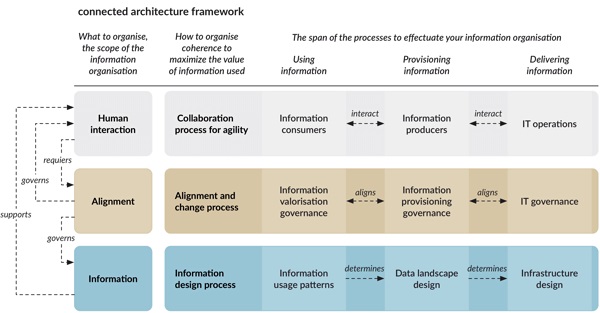
Enhance BI Delivery Using a New Framework
The Connected Architecture is one part of an approach to enhancing your BI delivery.
- By Barry Devlin
- March 9, 2018
"Data gets value by applying the insights derived from it. Therefore, the responsibility for organizing data is with the people who apply the insights. They know what information they need," says Martijn ten Napel in a recent blog.
Organizing data into contextualized information is the first and most vital step toward making business decisions and taking action. Traditional BI practitioners know well that organizing (potentially) available data is often technically challenging, requiring data interpretation and information modeling skills found mostly in the IT department. Of course, IT is also where we find the familiar skills for data provisioning (such as delivering data from its increasingly varied and often poorly defined sources to users' desks).
It is an easy step to believe that IT must be responsible for organizing data as well as provisioning it. This is the traditional data warehouse approach, which works well when information needs are well defined and relatively stable. However, in times of rapid change, as now, IT can become a bottleneck. In response, Gartner and others promote self-service BI, which shifts responsibility for the entire gamut of organizing, provisioning, and use of information to business users, often with predictably chaotic results.
In the face of constant and continuous change -- in business needs, legislation, and organization; in data types and sources; and in technology-- we must actively avoid and reduce complexity in every aspect of information design, delivery, and use. Change management and complexity avoidance are human skills embedded in organizational structures. Increasingly, technology is part of both the problem and the solution.
We thus need organizational structures where business and IT work together in an agile and coherent manner. Making this happen is no easy task. We need a mental construct -- an architecture -- to visualize the components and interactions of this blended organization to enhance BI delivery.
Introducing the Connected Architecture
The Connected Architecture -- designed by ten Napel and colleagues at the quirkily named Free Frogs consulting group in the Netherlands -- provides a framework, shown below, to design and implement the organizational structures needed.
At the top level of the architecture is human interaction. This thinking space identifies three classes of people -- information consumers, producers, and IT operations -- who interact and collaborate to enable effective information delivery and use. Calling out information producers -- "between" business and IT -- formally identifies a role combining these two skill sets as a basis for revamping the activities in the lower levels.

The Connected Architecture framework. Source: Connected architecture framework: emphasis on the organization of data by Martijn ten Napel, January 17, 2018
In the middle thinking space -- alignment -- people use alignment and change processes to manage and perform effective information value generation, data provisioning, and IT delivery in order to avoid or reduce system complexity. This three-way separation of concerns ensures that the business need to deliver value quickly is balanced with the IT need for a coherent data foundation.
In the information thinking space, the design emphasizes a flow from usage patterns -- the responsibility of information consumers -- through data landscape design to infrastructure. This unidirectional flow contrasts with the bidirectional flows at the higher levels: human interaction and alignment are collaborative processes, whereas information design starts with the business.
A deeper dive into the Connected Architecture is available here. People, process, and information thinking spaces originate in my Business unIntelligence architecture. Both approaches emphasize that architectural thinking must start from what people -- both business and IT -- want and how they behave. This contrasts with 1990s architectures such as those of Kimball and Inmon that start from information and infrastructure considerations.
Organizing Around Data Value
The BI Center of Competence (BICC) -- or, preferably today, Center of Excellence (CoE) -- is a well-known organizational structure for BI delivery. Its actual structure varies according to enterprise culture and history, leading to diverse and contradictory implementations. Now, the Connected Architecture offers valuable guidance on its placement and activities.
The principle that business is responsible for organizing data implies that the CoE should reside on the business side of the enterprise, not within IT. Nonetheless, the roles identified in the human interaction space clearly span both business and IT. Users must respect the CoE leader, who must understand in depth both business and IT concerns and drive the CoE accordingly.
Within the alignment space, governance of business information value may be a novel concept for many. Nevertheless, it is vital because a successful CoE becomes the nexus of all requests for information, both new and changed. In the Connected Architecture, prioritizing requests begins with enterprisewide business value but balances the competing considerations of ease of provisioning the requested data and availability of prerequisites.
Determining usage patterns is the starting point in the information space. The CoE focus is on the overall pattern of information use within the business and how usage changes -- often rapidly -- over time. A successful CoE balances project-level and enterprise-level information needs, enabling agile project delivery in the context of cross-enterprise strategies.
The Connected Architecture is but one part of a wider approach to enhancing BI delivery. However, its emphasis on human interactions and organizational concerns offers a novel and useful starting point for planning how to implement a new BI CoE or to restructure an old BICC that no longer delivers data value.
For Further Reading:
Balancing Self-Service, Governed BI, and Analytics
Wanted: A Data Architecture for On-Demand Data Access
Evolving the Data Warehouse
About the Author
Dr. Barry Devlin is among the foremost authorities on business insight and one of the founders of data warehousing in 1988. With over 40 years of IT experience, including 20 years with IBM as a Distinguished Engineer, he is a widely respected analyst, consultant, lecturer, and author of “Data Warehouse -- from Architecture to Implementation" and "Business unIntelligence--Insight and Innovation beyond Analytics and Big Data" as well as numerous white papers. As founder and principal of 9sight Consulting, Devlin develops new architectural models and provides international, strategic thought leadership from Cornwall. His latest book, "Cloud Data Warehousing, Volume I: Architecting Data Warehouse, Lakehouse, Mesh, and Fabric," is now available.